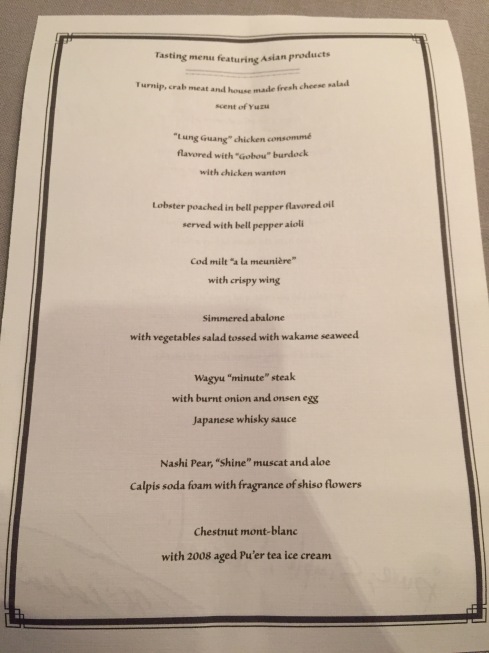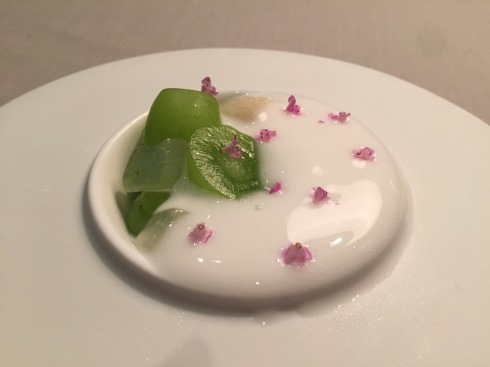- Rating: (after 2 tasting meals): 13/20 (first tasting 15/20, second tasting 7/20)
- Number of visits: 3 (twice in Jan ’15 – Feb ’15, once in Jun ’15)
- One-line review:Wild Rocket is the oldest of the “Modern Singaporean” restaurants, started in 2005 by lawyer-turned-chef Willin Low. He cooks off-beat renditions of Singapore classics, and has been widely known as one of the first chefs to cook upmarket food in this manner.Recently, the food has been described by local commentators as Japanese-inspired because it has comprehensive sake pairings and clean plating aesthetics, and has a strong focus on seafood (5 dishes had seafood as principal components), raw (scallops), semi-raw (negitoro), or in a croquette (two types of crab). The cooking is not overly complicated, but focused on 2-3 principal ingredients (as opposed to 4-5 for Labyrinth, and the thick carpets of sauce at Candlenut). The standout dish of my tasting menu meal there was a thai pomelo salad with a savory ice cream, though I found the 4-course option on another night a bit more hit-and-miss. Overall I found it my first meal (in February) there enjoyable and assured. (15/20)However, I came in later in the year (around June) for another dinner, and found it very disappointing. There were no standout dishes, not any luxury ingredients despite charging $150+ per person. What I disliked most was when others in my table were served grilled king prawn noodles, I was served a very simple noodle dish stir-fried with kai lan (noodles with vegetables) merely because I had tried the king prawn dish before. To add insult to injury, the dish was described as having truffles (to justify its substitution) when it clearly had no truffles of any sort. It is one thing to have a very ordinary dish dish, it is worse when it is inferior to the normal offering, but to claim it is some sort of premium offering when it isn’t takes the cake. The dishes that night were subpar (perhaps because Chef Willin was not in that night), and I found myself thinking it was a waste of money. On the basis of the two tasting menus I’ve had this year (+ 1 4-course meal), I think the kitchen is (1) inconsistent and (2) the ingredients do not really justify the price. If one is looking for a fine-dining experience, a better value-bet is to dine at Les Amis instead.
How can a restaurant charging $150 per person use canned pineapple in its dishes, and mislead diners about having truffle in its dishes? The ingredients are just subpar for the price.
I will say however that service is excellent – and Ram and Willin are generous and knowledgeable. If you do come, make sure to drop by on a night that the chef is in. - Memorable dishes: Thai pomelo salad ice cream, sugee cake
- Other links: Aun Koh’s review, Wong Ah Yoke’s review
FIRST MEAL
- “Chee kueh” Hokkaido scallop carpaccio with chai poh & truffle infusion
- Flavored with truffle bits and truffle oil (3.75/5)
- “Thai pomelo salad”, fish sauce and coconut ice cream, peanuts, onions
- Inspired dish (4.5/5)
- “Bak chor mee” Glass noodles, iberico pork fat, torched tuna (scrapings from the bone)
- I enjoyed the fatty tastes, but it felt underseasoned to my taste. (3.5/5)
- See this video for tuna scrapings: http://mesubim.com/2015/04/04/tuna-step-3-bluefinomics
-
- “Tea leaf egg” Quail egg in pu erh, cod, Savoy cabbage (4/5)
-
- “Singapore fried noodles”: Hokkien mee pasta, shio kombu, prawn stock from head, lobster oil
- It had a distinct “wok-fried” fragrance
- 4.5/5
- Croquette of two crabs: Australian spanner crab on outside acting as glue for the croquette, Vietnamese blue swimmer crab on the inside for sweetness. A duck egg sauce below, acting as sweet custard, like liushabao.
- The crab inside was a bit dry. 3.5/5
- “Beef hor fun” short rib, 48 hour sous vide. Black bean sauce.
- 3.75/5
- Black bean provided saltiness. One “hor fun” piece had the saltiness of black bean, the other did not. The one with, was markedly better.
- Sarawak pineapple sorbet, with vacuum sealed pineapple, mint sugar, chilli, soy salt from Kwong Woh Hin
- Vacuum sealing the pineapple is claimed to improve the sweetness of the fruit.
- A comforting mouthful of cake, with a rich ice cream (4.25/5) “The secret is to mix coconut water with coconut cream to ensure a profound coconut flavor, because coconut cream by itself is very fatty.”
SECOND VISIT
- Hokkaido scallop carpaccio, shio kombu, truffle oil
- Red Thai duck curry salad. (3.25/5)
- canned pineapple was used.
- Shrimps paste “har cheong” pigs ear, home made tartare sauce, mango salsa (4/5)
- Char kuey teow with cuttlefish (4/5) Wok hei was good.
- Kai lan pasta reduction (2.5/5)
- This was served in place of one of the better dishes here (the king prawn noodles), and was just kailan stir fried with noodles. It was represented as having truffles – but I detected nothing of the sort
- Barramundi liver, ginger confit, claypot rice 3.5/5
- Rack of lamb tandoori, herbs and spices, cauliflower papadum, raitah. (3/5)
- Undersalted, and meat of ordinary quality.
- Sugarcane with some sorbet
- Pulut hitam ice cream (3/5)










































































































